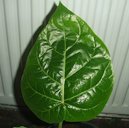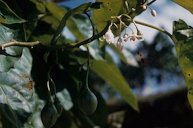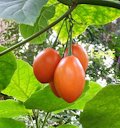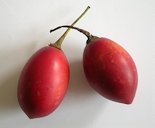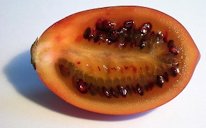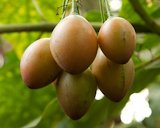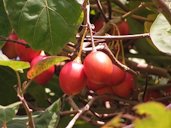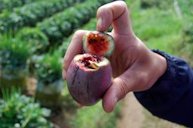| Tamarillo - Solanum betaceum | |||||||||||||||||||||||||||||||
|---|---|---|---|---|---|---|---|---|---|---|---|---|---|---|---|---|---|---|---|---|---|---|---|---|---|---|---|---|---|---|---|
 Fig. 1 Solanum betaceum 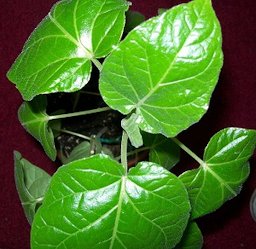 Fig. 2  Tamarillo seedlings, 6 months old  Fig. 3  Leaves and flowers 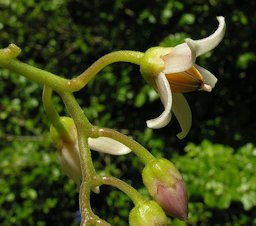 Fig. 6  S. betaceum, flower of the tree tomato, San Francisco Botanical Gardens.  Fig. 9  Unripe fruit 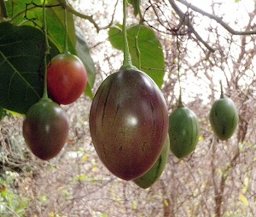 Fig. 10  Fruit habit 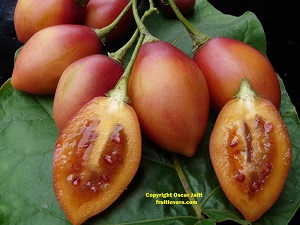 Fig. 11  Fig. 12  Purple-fruited form being grown at the Munich Botanic Garden, Germany  Fig. 20 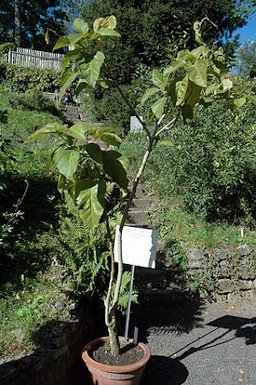 Fig. 21 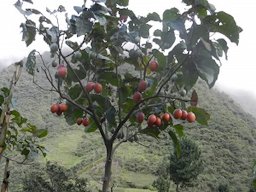 Fig. 22   Fig. 23 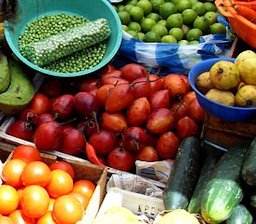 Fig. 24  Tree tomatoes, Ecuador  Fig. 25  Tamarillos, Indonesia  Fig. 26  Tamarillo apple chutney  Fig. 27  Tamarillo and vanilla tea cake  Fig. 31  C. betacea (Cav.) Miers |
Scientific
name Solanum betaceum Cav. Common names English: tree tomato, tamarillo, cape tomato, tomatillo, yellow tree tomato; Brazil: arvore do tomate, tomate de arvore, tomate francés; Bolivia: Lima tomate, tomate de monte, sima; Chinese: shu-fan-qie, shu-fan-ch’ieh; Colombia: pepino de arbol; Ecuador: tomate dulce; Costa Rica: tomate cimarron; Czech: rajčenka repovitá; Danish: trætomat; French: tamarille, tomate d’arbre, arbre a tomates, tomate de La Paz, tomate en arbre; German: tamarillo, Baumtomate; Guatemala: tomate, tomate extranjero, tomate de arbol, tomate granadilla, granadilla, pix, caxlan pix; Honduras: tomate de palo; Indonesia: terong belanda, terong menen; Italian: pomodora arboreo; Slovenian: tamarilo; Swahili: mgogwe; Swedish: trädtomat, tamarillo; Thailand: makhua-thetton (Chiang Mai); Uganda: munyanya (Luganda) 2,9,12 Synonyms Cyphomandra betacea (Cav.) Sendtn.; C. crassifolia (Ortega) J.F. Macbr.; C. crassifolia (Ortega) Kuntze; C. procera Wawra; Pionandra betacea (Cav.) Miers; S. betacea Cav.; S. crassifolium Ortega; S. insigne Lowe 8 Relatives Tomato, Lycopersicon lycopersicum, Mexican husk tomato, tomatillo, Physalis ixocarpa, Cape gooseberry, P. peruviana, pepino dulce, S. muricatum, naranjilla, S. quitoense, cocona, S. sessiliflorum 3 Family Solanaceae (nightshade family) Origin Native to the Andean region of South America 5 USDA hardiness zones 8-11 Uses Food Height 6-10 ft (1.8-3 m) Plant habit Perennial herbaceous shrub; single trunk; spreading lateral branches 10 Growth rate Fast Longevity Life on a commercial plantation is about 8 years Pruning requirement Annual pruning is advisable to eliminate branches that have already fruited and induce ample new shoots close to the main branches 2 Leaves Large; shiny; hairy; prominently veined; pungent smelling 10 Flowers Androgynous; small, pinkish, fragrant; several times a year Fruit Egg shaped; 2-3 in. (5-7.6 cm); smooth; long stemmed; red skin; many small seeds; mature 60-90 days after flowering Season Could grow all year round Nutrient Content pdf Light requirement Sun; will not grow in the shade Soil tolerances Fertile; good drainage; intolerant of heavy clays, compacted soils 12 pH preference 5.0-8.5 14 Drought tolerance Cannot tolerate prolonged drought 10 Wind tolerance Susceptible to wind damage because of its shallow-root system and large, soft leaves 13 Flood tolerance Not tolerant; water standing for even a few days may kill the tree 2 Soil salt tolerance Unknown Cold tolerance Frost tender 32 °F (0 °C) Plant spacing 6-10 ft (1.8-3 m); closer in windy locations 1 Roots Shallow, spreading root system 10 Pest/disease resistance Generally regarded as fairly pest-resistant Known hazards Unripe fruit is slightly toxic; the pigment stains badly and causes corrosion when in contact with metal surfaces 6 Reading Material Tomato Tree- Cyphomandra betacea (Cav.) Sendt, University of Florida pdf Tree Tomato, Fruits of Warm Climates "New" Solanums, Perspectives on New Crops and New Uses, Purdue University Tamarillo (Tree Tomato), Lost Crops of the Incas Tamarillo, California Rare Fruit Growers Cyphomandra betacea, Agroforestree Database In 1970, or shortly before, the construed name "tamarillo" was adopted in New Zealand and has become the standard commercial designation for the fruit. 2 'Tamarillo' was coined in 1967 and is now internationally accepted - even in South America where the fruit was formerly known as 'Tomate de arbol'. 5 Origin The tree tomato, originally named Solanum betaceum by Cavanilles in 1799, was transferred by Sendtner in 1845 to the genus Cyphomandra where it remained until recently when Bohs (1995) returned it to Solanum. As in the tomato, molecular studies prompted the recent change in the name (Olmstead and Palmer 1992; Spooner et al. 1993; Bohs and Olmstead 1998). More recent molecular studies have furnished additional support for its inclusion in Solanum (Bohs and Olmstead 1997; Olmstead and Palmer 1997). 9 Most likely introduced from India, where the fruit is well-known, the tamarillo is actually native to the Andean region of South America. It can be found from Venezuela to as far south as Argentina and is a typical fruit of the Andean highlands. 5 Distribution Although distributed throughout much of the world's subtropics, this little tree is usually produced only on a small scale in home gardens. Few people have ever considered it for large-scale orchard production, and it has hardly been developed commercially as yet. 10 Development of this crop is under way in one country, New Zealand, where tamarillos have been popular for more than 50 years. They got a particular boost during World War II, when bananas and oranges could not be imported. During the last half-century, New Zealand horticulturists have made selections, developed improved fruit types, and created a commercial industry. Indeed, the fruits have become widely popular—children take them to school in their lunch boxes, and until the kiwifruit “boom” of the 1960s, more New Zealand acreage was devoted to tamarillos than to kiwifruit. 10 Description Being a sub-tropical shrub, young trees are intolerant of frost; more mature trees will take a little frost as long as it is slight and infrequent. Trees prefer light, well-drained soils and need ample moisture throughout summer, however they will not stand waterlogging. The large leaves and extremely brittle branches make it very prone to wind damage, so they need to be protected with permanent windbreaks. The branches will break off easily when they are heavily laden with fruit, even in quite light winds. 4 Descriptors for tree tomato (Solanum betaceum Cav.) and wild relatives, Bioversity International pdf Leaves The evergreen musky, odorous, ovate, simple alternate leaves are large initially becoming smaller at later stages 4-14 in. (10-35 cm) long by 1.6-4.7 in. (4-12 cm) wide; they have a long petiole and are more or less heart-shaped at the base and pointed at the apex. The leaves are thin, softly hairy, with conspicuous coarse veins. 14
Flowers Borne in small, loose clusters near the branch tips, the fragrant flowers, 1/2 to 3/4 in (1.25-2 cm) wide, have 5 pale-pink or lavender, pointed lobes, 5 prominent yellow stamens, and green-purple calyx. 2 The plant will start flowering in its second growing season, and the sweet scent of its flowers alone makes it worth having in the garden. 5
Pollination There is no apparent pollination problem as the plant is self-fertile. Pollen transfer is accomplished by bees or shaking of the branches by the wind. 6 Fruit The long-stalked, pendent fruit, borne singly, or in clusters of 3 to 12, is smooth, egg-shaped but pointed at both ends and capped with the persistent conical calyx. In size it ranges from 2 to 4 in (5-10 cm) long and 1 1/2 to 2 in (4-5 cm) in width. Skin color may be solid deep-purple, blood-red, orange or yellow, or red-and-yellow, and may have faint dark, longitudinal stripes. Flesh color varies accordingly from orange-red or orange to yellow or cream-yellow. While the skin is somewhat tough and unpleasant in flavor, the outer layer of flesh is slightly firm, succulent and bland, and the pulp surrounding the seeds in the two lengthwise compartments is soft, juicy, subacid to sweet; it is black in dark-purple and red fruits, yellow in yellow and orange fruits. 2 The tamarillos produce their fruit on current season's growth.
Varieties There are apparently no named cultivars, but there are local preferences according to fruit color. Red fruits are chosen for the fresh fruit markets because of their appealing color. The dark-red strain (called "black") now leading in commercial plantings in New Zealand was obtained by selection around 1920 as a variation from the yellow and purple types grown up to that time. It was propagated and reselection thereafter resulted in this large, higher quality, red variety. Yellow fruits are considered best for preserving because of their superior flavor. 2 Trees will produce fruit after 18 months but it is considered advisable to remove the first year’s fruit in order to strengthen the root system. 1 Harvesting Look for full colouration (red or golden) on the fruit body up to the calyx (stalk). A slight loosening of the calyx attachment to the fruit (under which an orange colour is eventually seen), a slight softening of the fruit, and a yellowing of the green stalk are all indicators of fully ripe fruit. 11 To harvest, simply pull the fruit from the tree with a snapping motion, leaving the stem attached. The fruit can be stored in the refrigerator for up to 10 weeks, but temperatures below 38° F can cause the skin to discolor. 6 The fruit do not ripen simultaneously and several pickings are necessary. 14 Propagation Seeds or cuttings may be used for propagation. Seeds produce a high-branched, erect tree, while cuttings develop into a shorter, bushy plant with low-lying branches suitable for exposed, windy sites. 2,3 Plants from seed will start producing 8-10 months after transplanting. The fruit are ready for harvest in about 4 months from flowering. 14 The tree does not always come true from seed, but is most likely to if one is careful to take seed from red fruits with black seed pulp or yellow fruits with yellow seed pulp. 2 Planting Seedlings are field planted when they are 2 to 5 inches in height, spaced from 6 to 10 feet apart. In windy areas, they are often planted closer together. The flowers are often removed the first year and root growth encouraged. 1 Pruning Seedling trees are pruned back the first year after planting to a height of 3 or 4 ft (0.9-1.2 m) to encourage branching. Annual pruning thereafter is advisable to eliminate branches that have already fruited and induce ample new shoots close to the main branches, inasmuch as fruit is produced on new growth. Otherwise, the tree will develop a broad top with fruits only on the outer fringe. And wide-spreading branches are subject to wind damage. 2 Water shoots have thick green stems with long internodes. They tend to originate either from the main trunk of from deep within the canopy. They bear few fruit and only serve to direct the plant’s resources away from the remaining crop. As such, they should be pruned out completely as they arise during the growing season. 15 Pruning Tamarillos, West Australian Nut and Tree Crop Association
Irrigation The tree tomato cannot tolerate prolonged drought and must have an ample water supply during extremely dry periods. A mulch is very beneficial in conserving moisture at such times. 2 Pests A major pest on tamarillo is the tomato worm, the larva of the pyraustid moth Neoleucinodes elegantalis that also attacks the ordinary tomato and the pepino. Nematodes are a major problem in some areas. They affect the shallow root system and reduce the vigour and life of the plant. In soils heavily infested with nematodes it is frequently necessary to replant with new seedling material after two or three years. Aphids and white flies are sometimes a problem. 6 Diseases The principal disease is powdery mildew (both Erysiphe sp. and Oidium sp.), which may cause serious defoliation if not controlled. Minor problems include Sclerotinia disease (Sclerotinia sclerotiorum), the black lesions of which girdle stems and cause terminal wilting; and Ascochyta disease (Ascochyta sp.) which is evidenced by small, round, black, dead areas on leaves, especially mature leaves. Tree tomato mosaic virus causes pale mottling on leaves and sometimes on the fruits which has not been considered a serious disadvantage. Another virus disorder, called "bootlace virus", distorts the leaf, especially on young plants, reducing it to little more than the midrib. Affected plants are pulled up and destroyed. 2 Food Uses Ripe tamarillos may be merely cut in half lengthwise, sprinkled with sugar (and chilled if you like) and served for eating by scooping out the flesh and pulp. 3 Tree tomatoes are highly versatile for culinary use. They can be used as a substitute for tomatoes, cut fresh in salads, served sweetened in desserts or added to spicy sauces. Chutney made with the fruit is highly valued in New Zealand and often found served in place of tomato ketchup. West Hawai'i chefs have developed a number of recipes, curries and chutneys using the fruit. 1 When being cooked the seeds and skin of the tree tomatoes should be removed. This is easily done by pouring boiling water over the fruit and letting it stand for 1-4 minutes before peeling. 3,16 Being high in pectin, tamarillos make good jellies, jams, preserves, or chutneys, but they oxidize and discolor unless treated. The fruit freeze well, either whole (peeled) or pureed, and can be stored this way almost indefinitely. 10
Fig. 28. "We read how to eat them, and somewhere online, it just said to slice them open and eat them with a spoon, like a kiwi. Quite nice - both tart and sweet and it had seeds like a passion fruit." Fig. 29. Tamarillo and persimmon flan. Fig. 30. Love sorbet, New Zealand. Play on Pasta in Tree Tomato Sauce, Hawai'i Tropical Fruit Growers pdf Tamarillo (Tree Tomato), Twelve Fruits Project, University of Hawai'i at Mānoa Medicinal Properties ** Warmed leaves are wrapped around the neck as a remedy for sore throat in Ecuador. The fruit pulp, after having been cooked in embers, is used as a poultice for inflamed tonsils in Colombia. The species was known as ‘vegetable mercury’ in Jamaica because of its presumed therapeutic value to the liver. 13 Other Uses The leaves of the tamarillo have been employed as a dye. The unripe fruits are used in the Colombian tanning industry to decolour hides. 13 Ornamental: C. betacea is frequently grown as a curiosity in gardens in the temperate regions of North America. It is a common sight in homegardens of Latin America. 13 Intercropping: The species can be grown with crops such as coffee. Green manure or cover crops of grass and clover can be grown between rows. New Zealand growers often plant C. betacea as an intercrop in young citrus orchards. 13 Other Edibles in the Solanum Genus: Cocona, S. sessiliflorum Naranjilla, S. quitoense Pepino, S. muricatum General Although tamarillos are from South America, the name is not Spanish, but a New Zealand invention. The fruit was originally known as tree tomato, but to avoid confusion with the common tomato, and increase appeal to export customers, the New Zealand Tree Tomato Promotions Council decided to rename it. Council member W. Thompson came up with ‘tamarillo’, claiming it sounded both Māori and Spanish. The new name was officially adopted on 1 February 1967. 11 Further Reading The Tree Tomato, Tropical Fruit News, RFCI The Tree Tomato, Manual Of Tropical And Subtropical Fruits The Tree Tomato or 'Tamarillo', Archives of the Rare Fruit Council of Australia Brazenly Beautiful Tamarillo, Archives of the Rare Fruit Council of Australia Tree tomato (Cyphomandra betacea), Neglected crops All in the Family - The Tamarillo and its Relatives, Archives of the Rare Fruit Council of Australia Biodiversity of Food Species of the Solanaceae Family: A Preliminary Taxonomic Inventory of Subfamily Solanoideae, Resources pdf List of Growers and Vendors |
||||||||||||||||||||||||||||||
| Bibliography 1 Love, Ken. "Twelve Fruits with Potential Value-Added and Culinary Uses." University of Hawai'i at Mānoa, College of Tropical Agriculture and Human Resources, 2007. Accessed 18 Apr. 2015. 2 Fruits of Warm Climates. Julia F. Morton, Miami, 1987. 3 "Tamarillo." California Rare Fruit Growers, 1969-1989, crfg.org. Accessed 18 Apr. 2015. 4 Fletcher, W. A. "The Tree Tomato or 'Tamarillo'." Archives of the Rare Fruit Council of Australia, NZ Ministry of Agriculture, "Growing Tamarillos." Nov. 1990, rfcarchives.org.au. Accessed 18 Apr. 2015. 5 Endt, Dick. "All in the Family - The Tamarillo and its Relatives." Archives of the Rare Fruit Council of Australia, Extract from Quandong Vol.17 No.3, July 1992, rfcarchives.org.au. Accessed 19 Apr. 2015. 6 Schroeder, C. A. "Brazenly Beautiful Tamarillo." Archives of the Rare Fruit Council of Australia, Fruit Gardener (Magazine of the California Rare Fruit Growers), Nov. 1990, rfcarchives.org.au. Accessed 18 Apr. 2015. 7 "Solanum betaceum." Tropical Plants Database, tropical.theferns.info. Accessed 21 Apr. 2015. 8 "Tree tomato (Cyphomandra betacea)." Neglected crops: 1492 from a different perspective, FAO Plant Production and Protection Series, no.26, Food and Agriculture Organization of the United Nations, Rome, 1994, FAO, fao.org. Accessed 19 Apr. 2015. 9 Heiser, C., and G. Anderson. ""New" Solanums." Perspectives on New Crops and New Uses, Edited by J. Janick, pp. 379–384, 1999, NewCROP™, www.hort.purdue.edu/newcrop/proceedings1999/v4-379.html. Accessed 18 Nov. 2020. 10 "Tamarillo (Tree Tomato)." Lost Crops of the Incas: Little-Known Plants of the Andes with Promise for Worldwide Cultivation, National Research Council (U.S.), Advisory Committee on Technology Innovation, 1989, Internet Archive, Public Domain, archive.org/. Accessed 24 Nov. 2020. 11 "From Tree Tomato to Tamarillo - a Traditional Kiwi Food Icon." Tamarillo, Fruit for Life from New Zeland, NZ Tamarillo Growers Association, www.tamarillo.com/history. Accessed 24 Nov. 2020. 12 Lim, T. K. "Edible medicinal and non-medicinal plants, Fruits, vol. 6." ZLibrary, 2013, b-ok.cc/book/2144921/a9ea16. Accessed 5 Dec. 2020. 13 Orwa, C., et al. "Cyphomandra betacea (Cav.) Sendtner." Agroforestree Database: a tree reference and selection guide, version 4.0, 2009, Agroforestry, apps.worldagroforestry.org/treedb2/speciesprofile.php?Spid=639. Accessed 5 Dec. 2020. 14 Duarte, Odilo, and Robert E. Paull. Exotic Fruits and Nuts of the New World. Cambridge, CABI, 2015. 15 Sale, Pat. "Pruning Tamarillos, Influencing Yield, Fruit Size and Season of Maturity." Treen Orchard, Cambridge Road, RD4 Tauranga, New Zealand, WANATCA Yearbook Vol. 21, 1997, West Australian Nut and Tree Crop Association, Wayback, wayback.archive-it.org/1941/20100524190008/http://www.wanatca.org.au. Accessed 5 Jan. 2019. 16 Joyner, Gene. The Tree Tomato. Rare Fruit Council International Miami RFCI, Tropical Fruit News, Jan. 1993. Video v1 "Tamarillo Pruning and Maintenance." TvAgro por Juan Gonzalo Angel, 24 July 2015, (CC0), www.youtube.com/watch?v=uuQ48rB9X34. Accessed 6 July 2021. Photographs Fig. 1 Fibonacci. "Red and yellow tamarillos (tree tomatoes)." Wikimedia Commons, 2008, commons.wikimedia.org. Accessed 19 Apr. 2015. Fig. 2 Davidals. "6 months old tamarillo seedlings." Wikimedia Commons, 2004, Chapel Hill, North Carolina, (CC BY-SA 3.0), commons.wikimedia.org. Accessed 18 Apr. 2015. Fig.3 Cillas. "Cyphomandra betacea." Wikimedia Commons, Real Jardin Botanico de Madrid, GFDL, commons.wikimedia.org. Accessed 18 Apr. 2015. Fig. 4,5 B. Hans. "Solanum betaceum, own collection." Wikimedia Commons, 2006, Public Domain, commons.wikimedia.org. Accessed 13 Feb. 2017. Fig. 6 Culbert, Dick. "Solanum betaceum, flower of the Tree Tomato. Native to the northern Andes, where the fruit is called Tamarillo. San Francisco Botanical Gardens.' Flickr, 2006, (CC BY 2.0), flickr.com. Accessed 20 Apr. 2015. Fig. 7 Howard, R. A. "Cyphomandra betacea (Solanaceae)." US National Herbarium, Department of Botany, NMNH, Smithsonian Institution, Reynolds, Jamaica, nmnh.si.edu. Accessed 19 Apr. 2015. Fig. 8 Stueber, Kurt. "Cyphomandra betacea (Solanaceae), flower cluster." Wikimedia Commons, 2003, (CC BY-SA 3.0), GFDL, commons.wikimedia.org. Accessed 18 Apr. 2015. Fig. 9 Carstor. "Unripe fruit of Solanum betaceum (Solanaceae)." Wikimedia Commons, Jena Botanical Garden, Germany, 2007, commons.wikimedia.org. Accessed 18 Apr. 2015. Fig. 10 Tapson, Natalie. "Tamarillo fruit hanging from the bush." Flickr, 2010, flickr.com. Accessed 20 Apr. 2015. Fig. 11 Jaitt, Oscar. "Tree tomato, Tamarillo." Fruit Lovers, fruitlovers.com. Accessed 21 Apr. 2015. Fig. 12 Delso, Diego. "Purple-fruited form being grown at the Munich Botanic Garden, Germany." Tropical Plants Database, (CC BY-SA 3.0), tropical.theferns.info/image.php?id=Solanum+betaceum. Accessed 24 Nov. 2020. Fig. 15,16 Pfeifer, Janek. "Tamarillos (Solanum betaceum)." Wikimedia Commons, 2005, (CC BY-SA 3.0), commons.wikimedia.org. Accessed 18 Apr. 2015. Fig. 13 Stefano. "Cyphomandra betacea (Solanum betaceum)." Flickr, 2012, flickr.com. Accessed 20 Apr. 2015. Fig. 14 Bartsch, Michelle. "Tamarillo fruit, Palm House (also known as tree tomatoes)." Flickr, 2008, flickr.com. Accessed 20 Apr. 2015. Fig. 17 "Tree tomato (Cyphomandra betacea)." Flickr, Kew Gardens, London, England, 2011, (CC BY-NC-SA 2.0), flickr.com. Accessed 13 Feb. 2017. Fig. 18 Manners, Malcolm. "Tree Tomato, Cyphomandra betacea." Flickr, 2011, (CC BY 2.0), flickr.com. Accessed 13 Feb. 2017. Fig. 19,25 Kosters, Henk. "Tamarillo Indonesia." Flickr, 2012, (CC BY-NC-SA 2.0), flickr.com. Accessed 13 Feb. 2017. Fig. 21 Carstor. "Habit of Solanum betaceum (Solanaceae)." Wikimedia Commons, Jena Botanical Garden, Germany, 2007, commons.wikimedia.org. Accessed 18 Apr. 2015. Fig. 22 Brank Ljuba. "Tree tomatoes - a typical crop in the Andes in Ecuador." Tropical Plants Database, tropical.theferns.info. Accessed 21 Apr. 2015. Fig. 23 "Tamarillo - Cyphomandra betacea (Cav.) Sendt." UF/IFAS, AskIFAS, edis.ifas.ufl.edu. Accessed 18 Apr. 2015. Fig. 24 Ekem. "Tree tomatoes, Ecuador." Wikimedia Commons, 2009, commons.wikimedia.org. Accessed 18 Apr. 2015. Fig. 26 Balasubramanian, Aparna. "Tamarillo Apple Chutney." Diverse Kitchen, 25 Oct. 2018, (CC BY-NC-ND 4.0), Image cropped, www.mydiversekitchen.com/tamarilllo-apple-chutney. Accessed 6 July 2021. Fig. 27 Yee, Helen. "Tamarillo and vanilla tea cake." Grab Your Fork, Wellington on a Plate food festival, 27 Aug. 2009, (CC BY-NC-ND 3.0) , grabyourfork.blogspot.com/2009/08/floriditas-wellington-new-zealand.html. Accessed 6 July 2021. Fig. 28 Su-Lin. "Our First Tamarillo." Flickr, 2008, (CC BY-NC-SA 2.0), flickr.com. Accessed 13 Feb. 2017. Fig. 29 Laugher, Brianna. "Tamarillo and persimmon flan." Flickr, 2011, (CC BY-SA 2.0), flickr.com. Accessed 13 Feb. 2017. Fig. 30 Clunie, Moira. "Love sorbet, New Zealand." Flickr, 2009, (CC BY-NC-SA 2.0), flickr.com. Accessed 13 Feb. 2017. Fig. 31 Smith, M. "Cyphomandra betacea (Cav.) Miers." Curtis’s Botanical Magazine, vol. 125 [ser. 3, vol. 55]: t. 7682, Missouri Botanical Garden, St. Louis, U.S.A., 1899, Plant Illustrations, plantillustrations.org. Accessed 18 Apr. 2015. * UF/IFAS Assessment of Non-native Plants in Florida's Natural Areas ** Information provided is not intended to be used as a guide for treatment of medical conditions. Published 20 Apr. 2015 LR. Last update 28 May 2024 LR |
|||||||||||||||||||||||||||||||

